The Economics and Statistics Division maintains archives of previous publications for accountability purposes, but makes no updates to keep these documents current with the latest data revisions from Statistics Canada. As a result, information in older documents may not be accurate. Please exercise caution when referring to older documents. For the latest information and historical data, please contact the individual listed to the right.
<--- Return to Archive
For additional information relating to this article, please contact:
April 25, 2024JOB VACANCIES, FEBRUARY 2024 Monthly (February 2024 vs January 2024, seasonally adjusted)
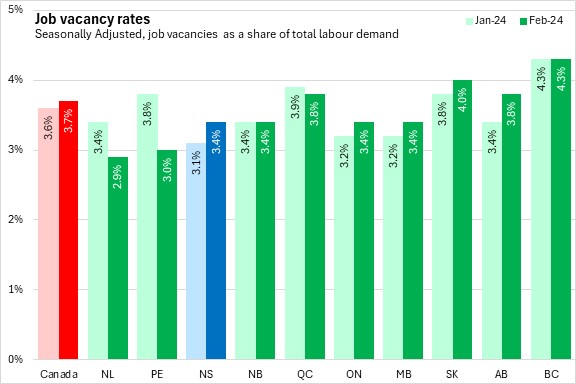
Nova Scotia had 15,840 job vacancies in February 2024 with a vacancy rate of 3.4%. Canadian employers were actively recruiting for 656,680 positions in February with a vacancy rate of 3.7%. The national job vacancy rate rose by 0.1 percentage point in February 2024 with five provinces reporting higher vacancy rates. The highest vacancy rate was reported in British Columbia and the lowest vacancy rate was reported in Newfoundland and Labrador.
When compared to January 2024, the number of job vacancies in Nova Scotia rose 9.7% (+1,395 jobs). National job vacancies rose 3.4% (+21,775 jobs). Job vacancies increased in five provinces led by Alberta, followed by Nova Scotia. The fastest declines in job vacancies compared to January were in Prince Edward Island and Newfoundland and Labrador.
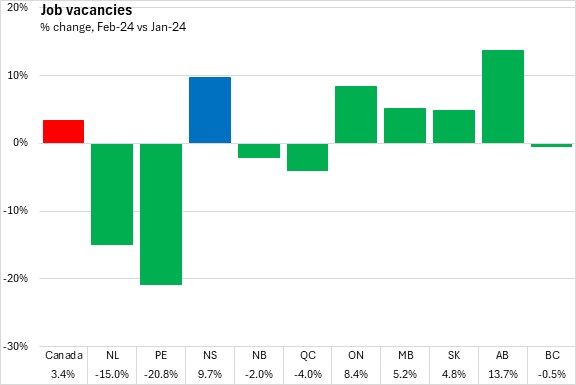
Year-over-year (February 2024 vs February 2023)
When compared to February 2023, the job vacancy rate in Nova Scotia declined 1.1 percentage points. Nationally, job vacancy rate declined from 4.7% to 3.7%. Compared to one year earlier, the job vacancy rate declined in all provinces.
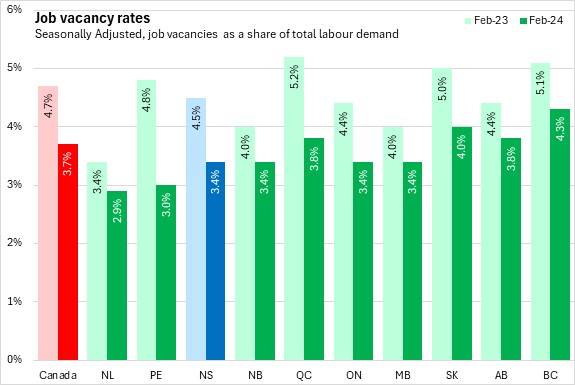
When compared to February 2023, the number of job vacancies in Nova Scotia declined 23.6% or 4,900 vacancies. National job vacancies declined 21.4% or 178,370 vacant jobs. All provinces saw declines in the number of vacancies over the twelve month period ending in February. In percentage terms, Prince Edward Island declined the most and Newfoundland and Labrador declined the least compared to February 2023.
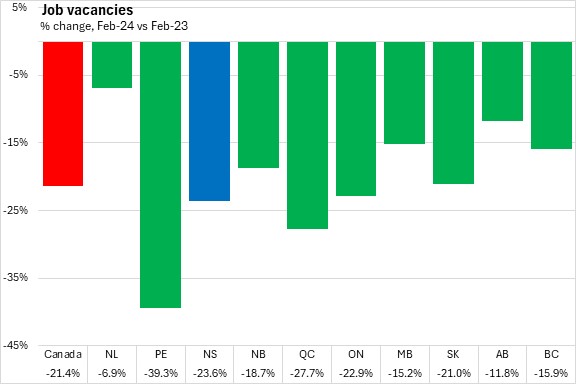
Trend
Nationally, job vacancy rates trended downward after peaking in March-May 2022. The national job vacancy rate has fluctuated between 3.6% and 3.8% since the fall of 2023. Nova Scotia's job vacancy rate peaked in the spring of 2022 and has also been on a downward trend. The Nova Scotia job vacancy rate has been below the national rate for most of this period.
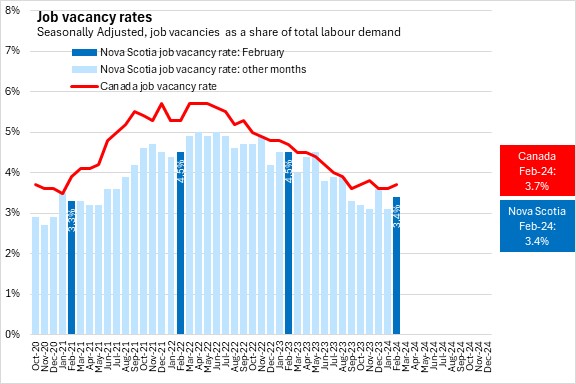
Nova Scotia's job vacancies peaked at 22,715 in June 2022.
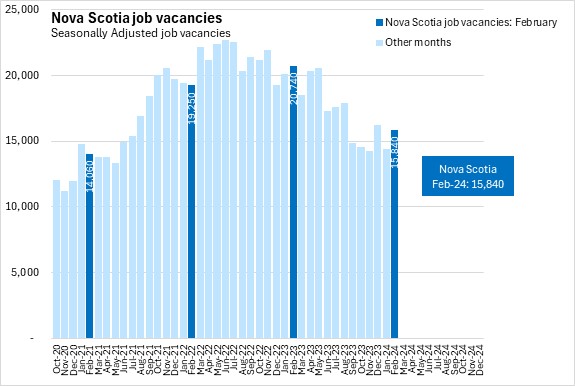
Canada job vacancy rate and job vacancies by industry, February 2024
Nationally, the accommodation and food services and health care and social assistance industries had the highest job vacancy rates. The lowest vacancy rates were in education and information/culture.
Health care and social assistance had the highest number of vacancies at 128,240 in February. Compared to February 2023, the number of vacancies declined in every industry except public administration.
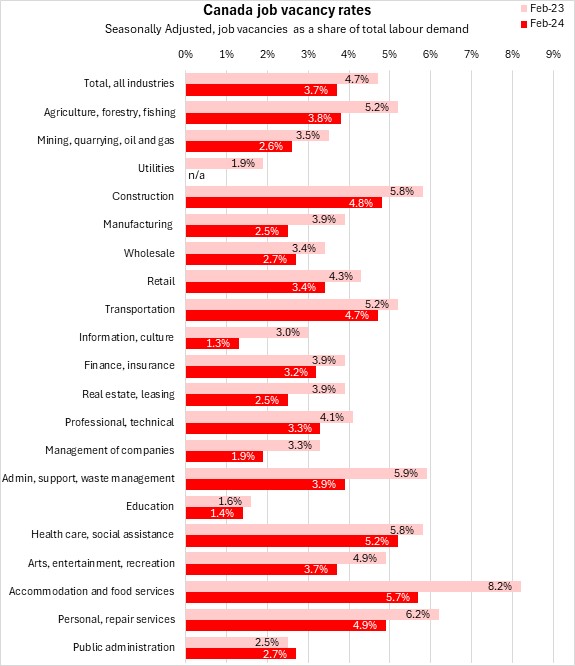
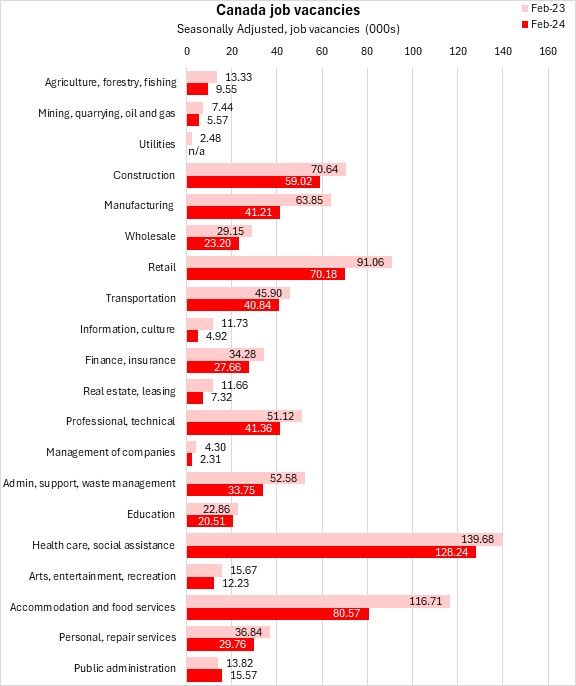
Notes: The job vacancy rate is the percentage of job positions (both filled and vacant) that are vacant. A higher job vacancy rate indicates a tighter labour market where it is more difficult for employers to find suitable candidates for the positions offered. A lower job vacancy rate signals labour market slack and potentially more job seekers competing for each vacant position.
Sources: Statistics Canada, Table 14-10-0432-01 Job vacancies, payroll employees, and job vacancy rate by provinces and territories, monthly, adjusted for seasonality, Table 14-10-0406-01 Job vacancies, payroll employees, and job vacancy rate by industry sector, monthly, adjusted for seasonality
<--- Return to Archive